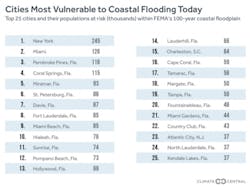Climate Change, Florida Wetlands Forcing Old Foes Onto Same Page
Be careful what you ask for…
In the mid-19th century, Florida’s state legislature recognized the potential of farming in the Everglades, considered by some to be the most fertile land anywhere. On July 4, 1906, the first dredging project in South Florida began, and draining and widespread development – for both agriculture and building – continued well into the 20th century.
Today, only 50 percent of the original wetlands remain. So in 2000, the U.S. Congress passed a $10.5-billion Comprehensive Everglades Restoration Plan (CERP)… the largest project of its type ever attempted.
Fast forward to modern day South Florida’s storm surge and sea-level rise problems and, as Yogi Berra would say (ask your parents if you don’t know who that is), it’s "déjà vu all over again." Since shortly after Hurricane Irma inundated Miami with as much as six feet of water in 2017, the U.S. Army Corps of Engineers has been studying ways to mitigate the effects of storm surge on South Florida’s vulnerable coastline. Of the 25 cities most at risk in the entire U.S., 22 are in Florida. And all but two of them are in South Florida.
Recently, the Corps released its initial recommendation: Build a seawall six miles long, at a projected cost of $6 billion. But it wasn’t the price tag alone that made the residents gulp. It was the idea of putting a 20-foot-high wall across a mile of Biscayne Bay. The impact on the pricey condos on the beach, and on the Miami financial district offices that call Brickell high-rises home, is a bitter pill for local residents to swallow.
These are not climate change deniers. They are folks who understand the link between global warming and sea-level rise, and they are already feeling the economic effects of it. Hurricane insurance premiums continue to rise, and coverage is becoming more difficult to obtain. Just last month, in fact, Florida’s insurance regulators approved a request from three insurers to cancel more than 50,000 home insurance policy holders due to out-of-control claims losses and litigation expenses. And it’s not just coastal residents who are affected. When I first wrote about sea-level rise in 2013, saltwater infiltration of aquifers and well fields was already impacting the drinking water of inland residents, as well.
Today, for the first time in quite a while, environmental advocates and real estate investors agree about something: protecting the at-risk assets shouldn’t significantly lower the value of those assets.
But that may well be the case if this seawall is actually built at Biscayne Bay. Subsequent damage to the bay’s fragile and diverse ecology could be significant. In fact, some old-timers are now comparing the Corps of Engineer’s seawall plan to the draining and dredging of the Everglades for all of those years, which resulted in widespread development and caused substantial damage to the environment.
Climate change is real and sooner or later, just as the residents of Miami are doing now, we are all going to have to come to grips with it.
##########
- Listen to Larry Clark in the first episode of our podcast series, HPAC On the Air.
##########
A regular contributor to HPAC Engineering and a member of its editorial advisory board since 2012, Clark, LEED AP, O+M, is a principal at Sustainable Performance Solutions LLC, a south Florida-based engineering firm focusing on energy and sustainability. Email him at [email protected].
About the Author
Larry Clark
A member of HPAC Engineering’s Editorial Advisory Board, Lawrence (Larry) Clark, QCxP, GGP, LEED AP+, is principal of Sustainable Performance Solutions LLC, a South Florida-based engineering firm focused on energy and sustainability consulting. He has more than two dozen published articles on HVAC- and energy-related topics to his credit and frequently lectures on green-building best practices, central-energy-plant optimization, and demand-controlled ventilation.

